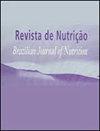Accuracy of the Global Leadership Initiative on Malnutrition to identify malnutrition in hospitalized patients
IF 0.5
4区 医学
Q4 NUTRITION & DIETETICS
Revista De Nutricao-brazilian Journal of Nutrition
Pub Date : 2022-01-01
DOI:10.1590/1678-9865202235e220048
引用次数: 0
Abstract
ABSTRACT Objective: The Global Leadership Initiative on Malnutrition, introduced as a useful method in the diagnosis of malnutrition, is supported by little evidence in hospitalized individuals. Therefore, we reviewed this method with two objectives: 1) to compare the diagnostic accuracy of the Global Leadership Initiative on Malnutrition criteria with the Patient-Generated Subjective Global Assessment; 2) to determine the prevalence of malnutrition and its associated factors. Methods: Cross-sectional study, conducted with individuals hospitalized between April 2019 and July 2021. Sociodemographic, clinical and anthropometric information was investigated. Global Leadership Initiative on Malnutrition was the index test and Patient-Generated Subjective Global Assessment the standard reference to assess malnutrition. For diagnostic accuracy, measurements of sensitivity, specificity, area under the curve and kappa agreement were considered. Results: A total of 105 individuals participated (age 65.9±9.9 years). The prevalence of malnutrition in the total sample was 48.6% and 67.6% according to the Global Leadership Initiative on Malnutrition and Patient-Generated Subjective Global Assessment criteria, respectively. An association was observed between malnutrition and the variables that stand behind hospitalization, metabolic stress and anthropometric indicators (p<0.05). The comparison showed sensitivity and specificity values for the Global Leadership Initiative on Malnutrition criteria of 67.6% (95% CI: 56.1-77.3) and 91.2% (95% CI: 77.0-96.9) (total sample) and 71.7% (95% CI: 58.4-82.0) and 95.5% (95% CI: 78.2-99.2) (elderly), respectively. An agreement of 49% was observed, raising to 55% when the elderly were assessed separately. Conclusion: The Global Leadership Initiative on Malnutrition criteria presented adequate sensitivity conditions and specificity to diagnose malnutrition, moderate agreement with the reference standard and good applicability in hospitalized patients’ clinical practice. Prevalence of malnutrition was high, regardless of the method used, and was associated with the reason for hospitalization, metabolic stress and anthropometric indicators.全球营养不良领导倡议确定住院患者营养不良情况的准确性
摘要目的:作为营养不良诊断的一种有用方法,全球营养不良领导倡议(Global Leadership Initiative on nutrition)在住院患者中得到的证据很少。因此,我们对这种方法进行了回顾,目的有两个:1)比较全球营养不良领导倡议标准与患者主观全球评估的诊断准确性;2)确定营养不良的患病率及其相关因素。方法:对2019年4月至2021年7月住院的患者进行横断面研究。调查了社会人口学、临床和人体测量学信息。全球营养不良领导倡议是评估营养不良的指标测试,患者主观全球评估是评估营养不良的标准参考。为了诊断的准确性,考虑了敏感性、特异性、曲线下面积和kappa一致性的测量。结果:共105人参与,年龄65.9±9.9岁。根据全球营养不良领导倡议和患者主观全球评估标准,总样本中营养不良的患病率分别为48.6%和67.6%。观察到营养不良与住院治疗、代谢应激和人体测量指标背后的变量之间存在关联(p<0.05)。比较显示,全球营养不良领导倡议标准的敏感性和特异性值分别为67.6% (95% CI: 56.1-77.3)和91.2% (95% CI: 77.0-96.9)(总样本)和71.7% (95% CI: 58.4-82.0)和95.5% (95% CI: 78.2-99.2)(老年人)。研究人员观察到49%的人同意,当老年人单独接受评估时,这一比例上升到55%。结论:全球营养不良领导倡议标准对诊断营养不良具有足够的敏感性条件和特异性,与参考标准的一致性中等,在住院患者的临床实践中具有较好的适用性。无论采用何种方法,营养不良的发生率都很高,并且与住院的原因、代谢压力和人体测量指标有关。
本文章由计算机程序翻译,如有差异,请以英文原文为准。
求助全文
约1分钟内获得全文
求助全文
来源期刊
CiteScore
1.20
自引率
12.50%
发文量
24
审稿时长
6-12 weeks
期刊介绍:
Revista de Nutrição is former Revista de Nutrição da Puccamp, founded in 1988. It is a bimonthly publication every four months and it is of responsibility of the Centro de Ciências da Vida, da Pontifícia Universidade Católica de Campinas . It publishes articles that contribute to the study of Nutrition in its many sub-areas and interfaces; and is open to contributions of the national and international scientific communities.

 求助内容:
求助内容: 应助结果提醒方式:
应助结果提醒方式:


